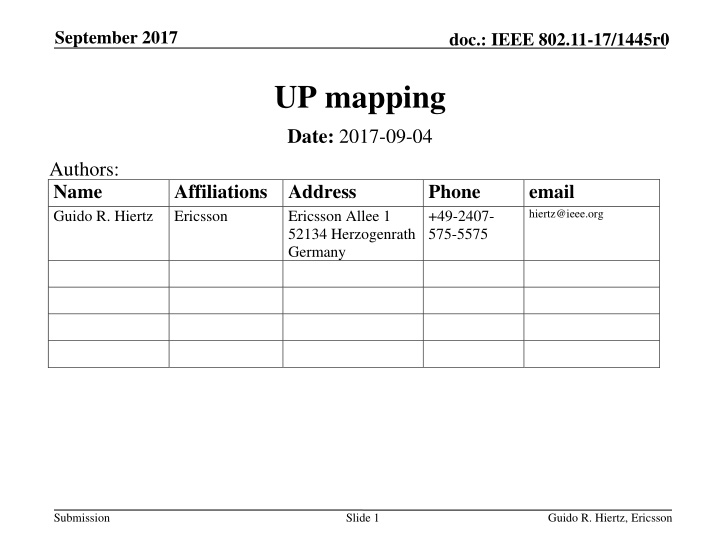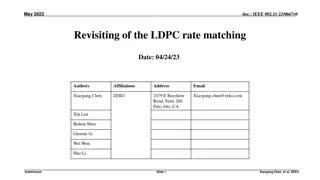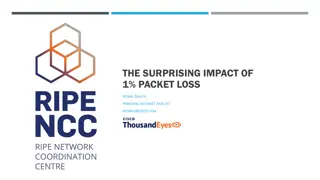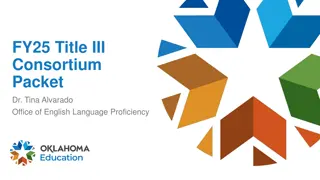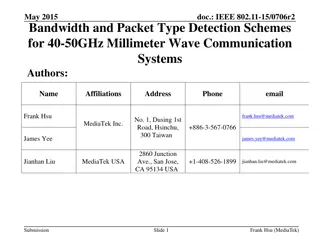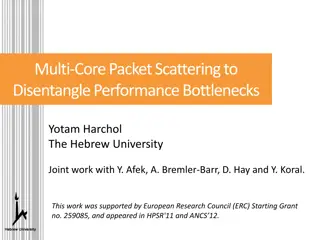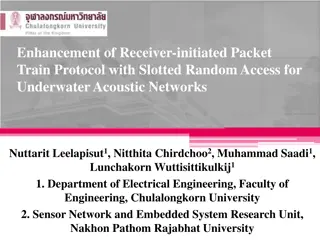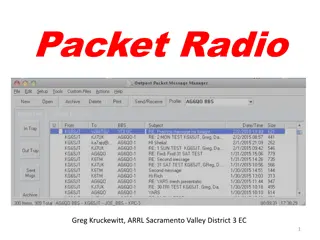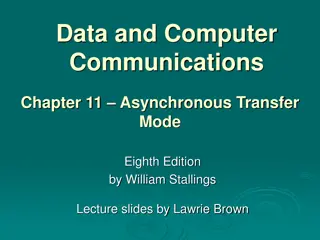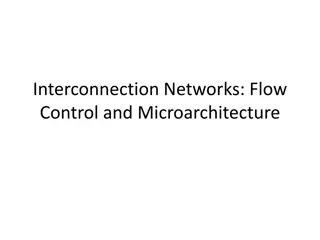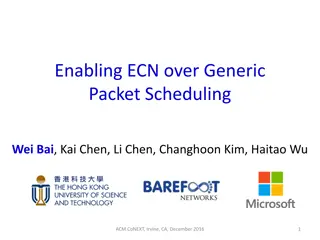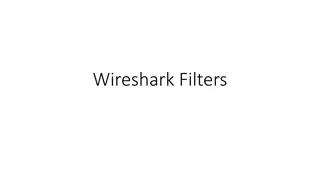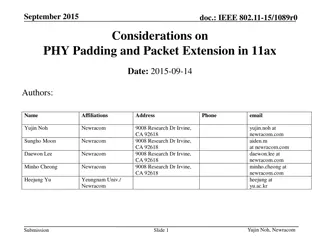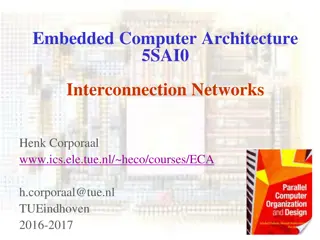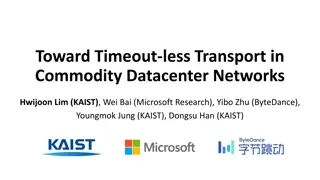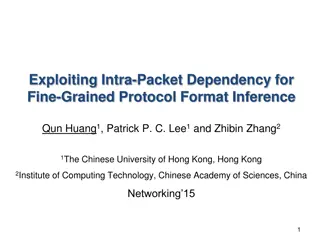Quality of Service Support in Packet Based Networks
Today's QoS support in packet-based networks relies on edge devices marking packets with DSCP. This document discusses the mapping between DSCP and UP in IEEE 802.11 standards, highlighting the challenges in serving VoIP packets efficiently and the current UP to AC mapping. It also addresses the DSCP settings for VoIP audio packets and the importance of proper mapping for ensuring quality audio transmission in network communication protocols.
Download Presentation

Please find below an Image/Link to download the presentation.
The content on the website is provided AS IS for your information and personal use only. It may not be sold, licensed, or shared on other websites without obtaining consent from the author.If you encounter any issues during the download, it is possible that the publisher has removed the file from their server.
You are allowed to download the files provided on this website for personal or commercial use, subject to the condition that they are used lawfully. All files are the property of their respective owners.
The content on the website is provided AS IS for your information and personal use only. It may not be sold, licensed, or shared on other websites without obtaining consent from the author.
E N D
Presentation Transcript
September 2017 doc.: IEEE 802.11-17/1445r0 UP mapping Date: 2017-09-04 Authors: Name Guido R. Hiertz Affiliations Address Ericsson Phone +49-2407- 575-5575 email hiertz@ieee.org Ericsson Allee 1 52134 Herzogenrath Germany Submission Slide 1 Guido R. Hiertz, Ericsson
September 2017 doc.: IEEE 802.11-17/1445r0 Abstract Today s Quality of Service support in packet based networks relies on edge devices marking packets Differentiated Service Code Points (DSCP) [2] used with Internet Protocol (IP) [1] is a trust and honor system Intermediate middle boxes should not alter the marking DSCP consists of 6 b 802 User Priorities (UPs) indicated by 3 b Mapping between DSCP and UP needed Most implementations map DSCP s three Most Significant Bits (MSBs) to 802 UPs The current mapping in 802.11-2016 fails to serve DSCP marked Voice over IP (VoIP) packets through Access Category Voice (AC_VO) Submission Slide 2 Guido R. Hiertz, Ericsson
September 2017 doc.: IEEE 802.11-17/1445r0 UP mapping in 802.11-2016 802.11-2016 follows 802.11D-2004 [6] for definition of UPs Because of IEEE 802 s legacy UP 0 has higher priority than UPs 1 and 2 Non-QoS bridges default to UP 0 Best Effort UP AC AC alternative BK BK BE BE A_VI VI VO A_VO 1 2 0 3 4 5 6 7 BK BK BE BE VI VI VO VO Submission Slide 3 Guido R. Hiertz, Ericsson
September 2017 doc.: IEEE 802.11-17/1445r0 QoS mapping [4] 4 b 4 b 8 b ... Version IP Header Length Type of Service 3 b 3 b 2 b RFC 791 Precedence TOS Reserved 6 b 2 b RFC 2474 & RFC 2475 DSCP ECN IPv4 example Deprecated Precedence [1] equals three Most Significant Bits (MSBs) of DSCP [2] IEEE 802 UP DSCP [0 63] 1:1 mapping DSCP (6 b) UP (3 b) Submission Slide 4 Guido R. Hiertz, Ericsson
September 2017 doc.: IEEE 802.11-17/1445r0 Voice over IP [4] DSCP setting for packets carrying audio [3] Expedited Forwarding (EF) DSCP(EF) = 1011102 1011102 = 4610 1011102 >> 3 = 1012 1012 = 510 UP (510) = AC Video (!) Mismatch between VoIP DSCP & 802.11 UP VoIP calls consist of Audio Signaling Audio is latency & loss sensitive Special marking of IP packets Submission Slide 5 Guido R. Hiertz, Ericsson
September 2017 doc.: IEEE 802.11-17/1445r0 Current UP to AC mapping 802.11D- 2004 [6] applied for current mapping 802.11aa introduces further differen- tiation for Voice and Video (alternative queues) 3 MSB [DSCP(101110)] = 1012 1012= 510 DSCP(EF) mapped to VI Submission Slide 6 Guido R. Hiertz, Ericsson
September 2017 doc.: IEEE 802.11-17/1445r0 A well known issue Cisco Unified Wireless QoS Tech Note [ ] DSCP Recommendation Due to the fact that more and more vendors use 802.1p-like markings over the air rather than the original 802.11e table (that is, voice is sent as 5 UP instead of 6), Cisco now recommends to trust DSCP end- to-end in order to avoid confusion and mismatches. DSCP also offers more values and choices, is more resilient to native VLANs, and is therefore more reliable to be preserved throughout the network. [8] ExpressRoute and QoS in Skype for Business Online [ ] It is important to note that there is a mismatch in the priority coding for IEEE 802.1p and WMM. The 802.1p the PCP value for voice is 5, however, in the standard equivalence mapping to WMM, PCP 5 is translated to Access Category 2, the WMM access category for video (AC_VI). If possible you should override that mapping so that PCP 5 translates to Access Category 1, or simply avoid using voice and video on the same Wi-Fi network until the Wi-Fi Alliance addresses this issue. [9] Submission Slide 7 Guido R. Hiertz, Ericsson
September 2017 doc.: IEEE 802.11-17/1445r0 802.1D vs. 802.1Q 802.1D-2004, Media Access Control (MAC) Bridges [10] 802.1Q-2014, Bridges and Bridged Networks [9] Submission Slide 8 Guido R. Hiertz, Ericsson
September 2017 doc.: IEEE 802.11-17/1445r0 Why is 802.1Q-2014 different? This discussion of traffic types, and the suggested association of each with a priority value, differs from [ ] Annex G of IEEE Std 802.1D-2004 and prior revisions of that standard. [ ] this annex better aligns with current practice; in particular, Voice is associated with priority 5, matching the setting of the relevant bits for Expedited Forwarding (EF) in the DSCP [ ] for IP Standards for DSCPs are believed to be the prime reference for use of priority by end stations [ ]. Already 802.1Q-2011 [7] introduces text in the right column IEEE 802 is fully aware of the interaction between DSCP and UP Unfortunately, 802.11 has not investigated this issue so far Submission Slide 9 Guido R. Hiertz, Ericsson
September 2017 doc.: IEEE 802.11-17/1445r0 Necessary modifications Order of Priorities must be modified New: Catego- rization of UP 2 is higher than UP 0 Internetwork and network control have higher priority than Voice Voice UP mapping to UP 5 coherent with IP DSCP marking Requires re-mapping of Video UP Submission Slide 10 Guido R. Hiertz, Ericsson
September 2017 doc.: IEEE 802.11-17/1445r0 Permutation of UPs Old UP 1 2 0 3 4 5 6 7 AC (old) alternative BK BK BE BE A_VI VI VO A_VO New UP 1 0 2 3 4 5 6 7 AC Old UP 1 2 0 3 4 5 6 7 AC (old) BK BK BE BE VI VI VO VO New UP 1 0 2 3 4 5 6 7 AC alternative BK BE BK BE A_VI VI VO A_VO BK BE BK BE VI VI VO VO Submission Slide 11 Guido R. Hiertz, Ericsson
September 2017 doc.: IEEE 802.11-17/1445r0 Rational of proposed modification 1. Consistency with 802.1Q Comply with general 802 architecture Consistency with widely used DSCP marking Dominant or sole source of QoS marking Consider increasing importance of VoIP over WLAN E.g. Wi-Fi calling Today, 802.11aa alternative queues seldom or never used No harm by introducing modifications 802.11 mostly used as final hop technology No Internetwork and network control messages exchanged No two background categories needed Coexistence: limit impact to existing (legacy) implementations New UP 1 0 2 3 4 5 6 7 AC AC AC AC alternative BK BK BK BE A_VI VI VO A_VO alternative BK BE BE A_VI VI VO VO A_VO 2. BK BE BK BE VI VI VO VO BK BE BE VI VI VO VO VO 3. 4. 5. 6. 7. Submission Slide 12 Guido R. Hiertz, Ericsson
September 2017 doc.: IEEE 802.11-17/1445r0 Minimizing modifications Blue marking indicates unmodified settings UPs 5 to 7 mapping to AC_VO Internetwork and network control fulfill similar tasks like 802.11 management frames Without QMF (802.11ae) all management frames map to AC_VO Consistency for video except for seldom used alternative queue UP 2 (Excellent effort) mapping to AC_BE With four queues [5] recommends supporting Network Control, Voice, Critical Applications, and Best Effort Deviation because importance of Video and 802.11 s dominant use as edge technology (no network control, see before) UP AC (old) BK BE BK BE VI VI VO VO AC AC (old) alternative BK BE BK BE A_VI VI VO A_VO AC alternative BK BE BE A_VI VI VO VO A_VO 1 0 2 3 4 5 6 7 BK BE BE VI VI VO VO VO Submission Slide 13 Guido R. Hiertz, Ericsson
September 2017 doc.: IEEE 802.11-17/1445r0 Conclusion The use of 802.11 has evolved and the UP marking in 802.11 did not keep up with recent advancements Past decisions impact today s use of 802.11 Compare to previous debates about Ethertype encapsulation (EPD) used by the vast majority of 802 networks and Logical Link Control (LLC) Protocol Discrimination (LPD) used in 802.11 The proposed modifications do not impact existing devices IP DSCP is the only reliable, widely used source of QoS marking Today s mismatch between 802.11 ACs and IP DSCP marking needs to be overcome The UP mapping is broken already today, no need to stick and comply with a known, wrong mapping The problem is only getting worse if 802.11 maintains its status quo Industry already applies workarounds Even worse, recommendations to avoid using voice and video on the same Wi-Fi network There is no legacy compatible solution that keeps the existing, wrong mapping while simultaneously complying with IP DSCP marking Currently, 802.11 harms itself when serving the VoIP market Submission Slide 14 Guido R. Hiertz, Ericsson
September 2017 doc.: IEEE 802.11-17/1445r0 References 1. 2. IETF, Internet Protocol, IETF RFC 791 K. Nichols et al., Definition of the Differentiated Services Field (DS Field) in the IPv4 and IPv6 Headers, IETF RFC 2474 J. Babiarz et al., Configuration Guidelines for DiffServ Service Classes, IETF RFC 4594 G. R. Hiertz, F. Mestanov, B. Hart, and S. Coffey, Efficiency enhancement for 802.11ax, IEEE 802.11 submission 11-15/871r3 IEEE, IEEE Standard for Local and metropolitan area networks Bridges and Bridged Networks, IEEE 802.1Q-2014 IEEE, IEEE Standard for Local and metropolitan area networks Media Access Control (MAC) Bridges, IEEE 802.1D-2004 IEEE, IEEE Standard for Local and metropolitan area networks Media Access Control (MAC) Bridges and Virtual Bridged Local Area Networks , IEEE 802.1Q- 2011 N. Tate and N. Darchis, Cisco Unified Wireless QoS Tech Note, July 2015. [Online]. Available: https://www.cisco.com/c/en/us/support/docs/wireless-mobility/voice-over- wireless-lan-vowlan/116056-technote-qos-00.html Microsoft, ExpressRoute and QoS in Skype for Business Online, [Online]. Available: https://support.office.com/en-us/article/20c654da-30ee-4e4f-a764-8b7d8844431d 3. 4. 5. 6. 7. 8. 9. Submission Slide 15 Guido R. Hiertz, Ericsson
